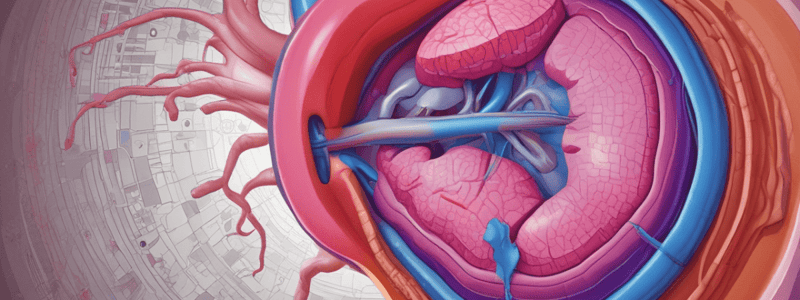Podcast
Questions and Answers
Which pathological change is most typical of severe hypertension?
Which pathological change is most typical of severe hypertension?
- Intracerebral hemorrhage
- Hypertensive heart disease
- Hyperplastic arteriolosclerosis (correct)
- Nephron loss and chronic renal failure
In malignant hypertension, the vascular changes are accompanied by which of the following?
In malignant hypertension, the vascular changes are accompanied by which of the following?
- Myocyte hypertrophy and cardiac dilation
- Dissecting aneurysm of the aorta
- Exacerbation of hypertension
- Fibrinoid deposits and vessel wall necrosis (correct)
How does nephron loss contribute to the progression of hypertension?
How does nephron loss contribute to the progression of hypertension?
- It causes intracerebral hemorrhage and subarachnoid hemorrhage
- It results in myocyte hypertrophy and cardiac dilation
- It leads to exacerbation of the hypertension, creating a vicious circle (correct)
- It is not directly linked to the progression of hypertension
What is the primary mechanism by which hypertension leads to hypertensive heart disease?
What is the primary mechanism by which hypertension leads to hypertensive heart disease?
Which of the following is NOT a vascular disorder associated with hypertension?
Which of the following is NOT a vascular disorder associated with hypertension?
What is the basic mechanism for established hypertension?
What is the basic mechanism for established hypertension?
Which type of hypertension may present with uncontrolled blood pressures possibly exceeding 220/120 mm Hg?
Which type of hypertension may present with uncontrolled blood pressures possibly exceeding 220/120 mm Hg?
What type of vascular wall change is typically associated with malignant hypertension?
What type of vascular wall change is typically associated with malignant hypertension?
What is a characteristic feature of hyaline arteriolosclerosis?
What is a characteristic feature of hyaline arteriolosclerosis?
In patients with established hypertension, which factor is primarily responsible for increased blood flow resistance?
In patients with established hypertension, which factor is primarily responsible for increased blood flow resistance?
Which of the following is the most characteristic feature of systemic hypertensive heart disease?
Which of the following is the most characteristic feature of systemic hypertensive heart disease?
What is the primary cause of left atrial dilation in systemic hypertensive heart disease?
What is the primary cause of left atrial dilation in systemic hypertensive heart disease?
In long-standing systemic hypertensive heart disease leading to congestive failure, what is the typical change observed in the hypertrophic left ventricle?
In long-standing systemic hypertensive heart disease leading to congestive failure, what is the typical change observed in the hypertrophic left ventricle?
Which of the following is a characteristic finding in malignant hypertension?
Which of the following is a characteristic finding in malignant hypertension?
What is the normal heart weight for a 60- to 70-kg individual?
What is the normal heart weight for a 60- to 70-kg individual?
What is the hallmark feature of hyaline arteriolosclerosis?
What is the hallmark feature of hyaline arteriolosclerosis?
Which condition is associated with benign hypertension and hyaline arteriolosclerosis?
Which condition is associated with benign hypertension and hyaline arteriolosclerosis?
What structural changes occur in large arterial blood vessels due to hypertension?
What structural changes occur in large arterial blood vessels due to hypertension?
Which process leads to diffuse vascular compromise and nephrosclerosis in the kidneys?
Which process leads to diffuse vascular compromise and nephrosclerosis in the kidneys?
What is the main cause of the thickening of the media layer of muscular arteries in response to hypertension?
What is the main cause of the thickening of the media layer of muscular arteries in response to hypertension?
Which of the following is NOT a pathological consequence of chronic hypertension?
Which of the following is NOT a pathological consequence of chronic hypertension?
Malignant hypertension is characterized by all of the following EXCEPT:
Malignant hypertension is characterized by all of the following EXCEPT:
Hyaline arteriolosclerosis is a pathological change associated with:
Hyaline arteriolosclerosis is a pathological change associated with:
Which of the following is the most accurate statement regarding the definition of hypertension?
Which of the following is the most accurate statement regarding the definition of hypertension?
Hyperplastic arteriolosclerosis is characterized by:
Hyperplastic arteriolosclerosis is characterized by:
Which of the following antihypertensive drug classes is most likely to cause cold extremities as a side effect?
Which of the following antihypertensive drug classes is most likely to cause cold extremities as a side effect?
Which antihypertensive drug class is most lipid soluble and therefore more likely to cross the blood-brain barrier?
Which antihypertensive drug class is most lipid soluble and therefore more likely to cross the blood-brain barrier?
Which of the following antihypertensive drug classes is most likely to cause claudication (cramping pain in the legs during exercise) as a side effect?
Which of the following antihypertensive drug classes is most likely to cause claudication (cramping pain in the legs during exercise) as a side effect?
Which antihypertensive drug class is most likely to cause electrolyte imbalances, such as hypokalemia, as a side effect?
Which antihypertensive drug class is most likely to cause electrolyte imbalances, such as hypokalemia, as a side effect?
Which antihypertensive drug class is most effective at reducing blood pressure by directly inhibiting the renin-angiotensin-aldosterone system?
Which antihypertensive drug class is most effective at reducing blood pressure by directly inhibiting the renin-angiotensin-aldosterone system?
Which of the following statements accurately describes the mechanism of action of spironolactone?
Which of the following statements accurately describes the mechanism of action of spironolactone?
Which class of antihypertensive medications is absolutely contraindicated during pregnancy due to potential teratogenic effects?
Which class of antihypertensive medications is absolutely contraindicated during pregnancy due to potential teratogenic effects?
Which of the following statements is correct regarding the use of antihypertensive medications in emergency hypertension?
Which of the following statements is correct regarding the use of antihypertensive medications in emergency hypertension?
Which of the following statements accurately describes the primary objective of antihypertensive treatment?
Which of the following statements accurately describes the primary objective of antihypertensive treatment?
Which class of antihypertensive medications is typically recommended as the first-line treatment, along with thiazide diuretics and calcium channel blockers, based on patient comorbidities?
Which class of antihypertensive medications is typically recommended as the first-line treatment, along with thiazide diuretics and calcium channel blockers, based on patient comorbidities?
Which of the following is a potential side effect of lipid-soluble beta-blockers that is NOT typically seen with water-soluble beta-blockers?
Which of the following is a potential side effect of lipid-soluble beta-blockers that is NOT typically seen with water-soluble beta-blockers?
Which of the following diuretic classes is most likely to cause hyperuricemia and precipitate gout?
Which of the following diuretic classes is most likely to cause hyperuricemia and precipitate gout?
Which of the following is a potential mechanism by which calcium channel blockers can improve claudication symptoms in patients with peripheral artery disease?
Which of the following is a potential mechanism by which calcium channel blockers can improve claudication symptoms in patients with peripheral artery disease?
Which of the following is a potential adverse effect of diuretic therapy that can exacerbate claudication and cold extremities?
Which of the following is a potential adverse effect of diuretic therapy that can exacerbate claudication and cold extremities?
Which of the following is a potential mechanism by which beta-blockers can worsen claudication and cold extremities in patients with peripheral artery disease?
Which of the following is a potential mechanism by which beta-blockers can worsen claudication and cold extremities in patients with peripheral artery disease?
Which of the following is a potential adverse effect of lipid-soluble beta-blockers?
Which of the following is a potential adverse effect of lipid-soluble beta-blockers?
Which of the following statements regarding calcium channel blockers (CCBs) is correct?
Which of the following statements regarding calcium channel blockers (CCBs) is correct?
Which of the following statements regarding diuretics in the management of hypertension is correct?
Which of the following statements regarding diuretics in the management of hypertension is correct?
Which of the following conditions is a contraindication for the use of non-dihydropyridine calcium channel blockers (e.g., verapamil, diltiazem) in the treatment of hypertension?
Which of the following conditions is a contraindication for the use of non-dihydropyridine calcium channel blockers (e.g., verapamil, diltiazem) in the treatment of hypertension?
Which of the following statements regarding the combination of beta-blockers and calcium channel blockers in the treatment of hypertension is correct?
Which of the following statements regarding the combination of beta-blockers and calcium channel blockers in the treatment of hypertension is correct?




